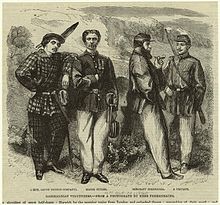The British Legion (1860)
| Expedition of the Thousand | |||||||
|---|---|---|---|---|---|---|---|
| Part of the wars of Italian Unification | |||||||
 The British Legion in Southern Italy |
|||||||
|
|||||||
| Belligerents | |||||||
|
Red Shirts |
|
||||||
| Commanders and leaders | |||||||
|
Giuseppe Garibaldi |
Francis II Giosuè Ritucci Lukas von Mechel |
||||||
The British Legion was a voluntary military corps composed of Englishmen and Scots, who in 1860 made their mind up to join Garibaldi during the Expedition of the thousand and fight for the unification of Italy together with the Italian Garibaldini against the Bourbon Army of The Kingdom of the Two Sicilies.
Officially they were “Garibaldi Excursionists” to avoid any problems of diplomatic appearance and were recruited by major Styles, who appears in the engraving wearing his uniform and medal of the Crimean War.
The departure of "The British Legion" was financed by the "Garibaldi Special Fund Committee", one of the British organizations supporting the unification of Italy.
The advertisement that enlisted them ran as follows:
“Excursion to Sicily and Naples. All persons (particularly Members of Volunteer Rifle Corps) desirous of visiting Southern Italy and of aiding by their presence and influence the “Cause of Garibaldi and Italy”, may learn how to proceed by applying to the Garibaldi Committee at the offices, No. 8 Salisbury Street, London."
The volunteers of the British Legion are described in a news item of “The illustrated London news” of Oct. 20, 1860 regarding the departure from Harwich of 800 Englismen and Scotchmen, who put their sword at the disposal of Garibaldi.
The “The illustrated London news” remarks that, including volunteers already with Garibaldi, the total amount is a considerable more than 1,000 volunteers in the Garibaldian Army, often from middle-class or well-paid jobs, who left their country attracted by adventure and love of freedom, to fight for the liberty of a foreign country.
Before their departure from England other British volunteers were already at the side of Garibaldi in the South of Italy, such as Hugh Forbes, who was with Garibaldi in 1849, taking part in the defence of the Roman Republic against the French troops supporting the papacy, John Whitehead Peard, the “double” of Garibaldi or the charismatic Colonel John Dunne and his “English battalion” whose soldiers were all Sicilians and called Dunne “Milordo”, Dunne was wounded in Capua, Percy Wyndam and several others. John Whitehead Peard tokk the lead of the British Legion after its landing in Naples.
After having sailed from Great Britain by the ships Melazzo and Emperor, the British Legion landed in Naples on 15 October 1860 and took part in a fight, under the command of John Whitehead Peard in Sant'Angelo up to the wall of Capua, where 2 volunteers were killed and 8 wounded.
Even if a half of the volunteers were enthusiastic and behaved properly, there were some roughs, principally from Glasgow and London who lacked discipline, so the Legion acquired a name for disorder similar to that which the Pope’s Irish had acquired in Rome. The Italians said “indulgently” , “these men are not accustomed to a country where wine is cheap.”
...
Wikipedia
